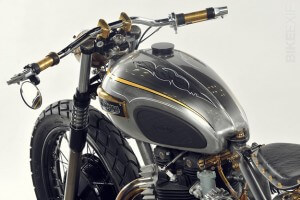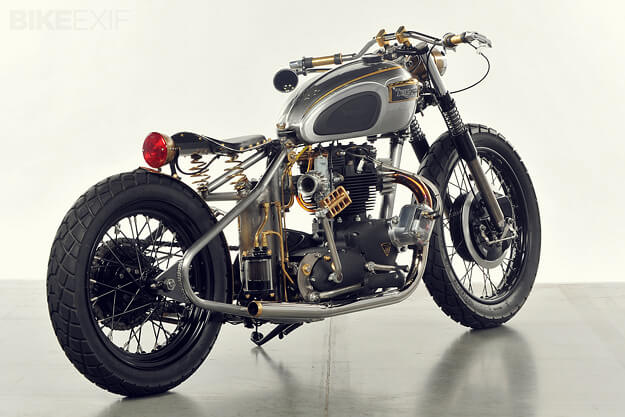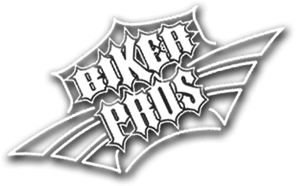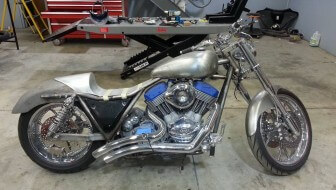Events: 2013 Chicago & Indy Ultimate Builder
Source: Bike EXIF
Photos: Biker Pros
More Steampunk Bikes: At Biker Pros
This Triumph T120 Bonneville is the personal ride of Tony Prust; it’s a more ‘traditional’ look than many Analog motorcycles, with a side order of steampunk too.
A Side Order of Steampunk
“El Matador” was a 2 year labor of love for Prust. It’s an elegant bike, finished in clear-coated raw metal with brass highlights. The frame came from a 1968 Triumph, and is now fitted with a bolt-on hardtail from Dave Byrd. The 650 motor is a 1972 specification, and was rebuilt by Ed Zender of the Triumph specialists Morrie’s Place. It’s now featured in a powdercoated wrinkle black.
Maund velocity stacks feed the engine, and the pipes are from Lowbrow Customs. The belt drive primary comes from Bob Newby Racing; the open cover was designed by Prust and Zander.
Up front, Prust has fitted the forks from a late 60s BSA. They’re hooked up to a twin leading shoe hub laced to 19″ rim, while the conical hub at the back is laced to a 16” Harley-Davidson rim. The tires are grippy dual-sport Kenda K761s, contrasting with the traditional nature of the rest of the build.
Prust gave the T120 a full rewire, and installed a Joe Hunt Magneto. (A neat touch is the vintage-style cloth wrapping on the wiring.) Hand-made parts include:
- Front lights
- Rear lights
- Solid brass rear fender (fabricated by 7 Metal West)
The oil plumbing is solid brass too, along with the tank badges and handgrips. The immaculate clear coat (with gold leaf and pinstriping) was applied by Brando Custom Paint.
It’s a little bit gothic and a little bit steampunk, and a showcase for Prust’s old-school fabrication skills. One of the classiest T120s we’ve seen for a long time.
Check out our Bike EXIF Archives for previous Analog builds, and the Analog Facebook page for news. Images by custombikeshows.com.
The 411 on Steampunk
Steampunk is a sub-genre of science fiction that typically features steam-powered machinery, especially in a setting inspired by industrialized Western civilization during the 19th century. Therefore, steampunk works are often set in an alternate history of the 19th century’s British Victorian era orAmerican “Wild West”, in a post-apocalyptic future during which steam power has regained mainstream use, or in a fantasy world that similarly employs steam power. Steampunk perhaps most recognizably features anachronistic technologies or retro-futuristic inventions as people in the 19th century might have envisioned them, and is likewise rooted in the era’s perspective on fashion, culture, architectural style, and art. Such technology may include fictional machines like those found in the works of H. G. Wells andJules Verne, or the modern authors Philip Pullman, Scott Westerfeld, and China Miéville. Other examples of steampunk contain alternate history-style presentations of such technology as lighter-than-air airships, analog computers, or such digital mechanical computers as Charles Babbage and Ada Lovelace‘s Analytical Engine.









